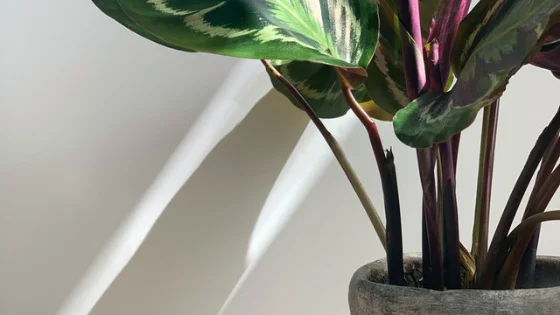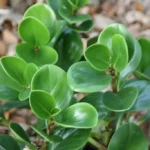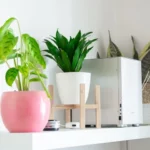Table of Contents
How to Care for Calathea makoyana
Calathea makoyana is an evergreen perennial famous for its beautiful multi-colored leaves that make it better known by its common names Peacock Plant and Cathedral Windows.
Native to eastern Brazil, Calathea makoyana is a compact species from the Marantaceae family that typically grows one to two feet in height.
Its ruddy colored stems terminate in large-oval shaped leaves that can be quite colorful.
The leaves can grow up to twelve inches long and are cream, white or pink in color with dark-green patterns displayed on their fronts. Like other prayer plants, this species folds its leaves at night or when it is dark.
What does your Calathea makoyana require?
Light Requirements
Calathea makoyana does not require much light and is actually happiest in part to full shade.
When placing your Calathea makoyana consider the following light requirements:
- Place your plant in a room that gets bright light, make sure the plant’s light itself is indirect.
- If your plant’s leaves are folded up, it is too dark and your Calathea makoyana may think it is night.
- Keep your plant out of direct sunlight, exposure to such light will most likely cause the color of leaves to fade.
- If your Calathea makoyana begins to fade, place sheer curtains on any windows in the room it is in to help filter the sunlight.
Temperature Requirements
Calathea makoyana will be happiest in normal household temperatures between 60-and 85-degrees Fahrenheit, the warmer the better for this plant.
- This plant can be grown outdoors, year-round, in USDA climate zones 10 through 11.
- Keep your plant out of hot or cold drafts, these can shock Calathea makoyana
Soil Requirements
Cathedral Windows require a nutrient-rich humus as the base of its potting soil. Using a majority of porous-potting medium and mixing it with other organic matter, like compost, will produce the most vibrant colored leaves.
In practice, this can be accomplished by combining two parts peat moss (or similar) with one part sand or perlite.
Only requires repotting up one size every two years, or as needed.
Humidity Requirements
Calathea makoyana require humid conditions in order to thrive, around 60% humidity is best, this can be hard to provide indoors, especially in colder winter climates.
If you are struggling with maintaining a proper level of humidity around your plant, here are a few tips:
- Try to place your Peacock Plant in a naturally humid environment, such as a bathroom or kitchen.
- Group plants that require high humidity close to one another, as this will raise humidity in the vicinity by itself.
- Invest in a pebble tray to place your plant on and keep it properly moistened.
- Place your plant in a room with a humidifier.
- As a last resort you can raise the humidity of a room by misting it yourself a handful of times a day. If you undertake this method, spray near your plant, but be sure its leaves aren’t wetted by the mist, as this can cause problems.
How to Water
- Water thoroughly during the spring to summer growing season, making sure that water pours out the pot’s drainage hole each time you do so.
- Water anytime the top inch of soil feels dry. If unsure, check by sticking your finger into the soil up to the first knuckle. Approximately once every five days, though it could be more or less depending on your specific plant.
- Reduce watering during the winter months. This can be once approximately every two weeks.
This plant is particularly sensitive to fluoride in its water. If your plant’s leaves begin to appear sickly, try collecting rainwater or use distilled water as its water supply.
How to Fertilize
Calathea makoyana is a moderately fast grower that requires a quality liquid fertilizer approximately once every two weeks from early April through the end of October.
Extra Tips for Calathea makoyana
Pests & Diseases
The following pests and diseases may pose a problem in cultivating your Calathea makoyana:
Calathea makoyana is particularly susceptible to red spider mites which will attack outer-leaf edges under dry, sunny conditions.
- Be sure to watch for other mites and aphids as well.
- Never leave in standing water, this may cause root rot.
- If a plant is struggling under low humidity, its leaves will start to brown and in some extreme cases will re-roll back up.
Pruning
As your plant matures you may find that outer leaves begin to become decrepit and turn yellow or brown. To improve the appearance of your Calathea makoyana these leaves can be easily pruned.
For pruning your Calathea makoyana you simply:
- First, make sure that the browning and yellowing of leaves is not widespread, as this can be a symptom of larger problems in your plant such as too much sun, water or it is diseased.
- Follow the stem of the troubled leaves in question to their base.
- Take a clean cutting implement and remove the stem at its base.
- Repeat as necessary, removing the damaged leaves from the container afterwards so as not to encourage anything like mold to grow.
Propagation
Propagation can be achieved through either taking a cutting or by a division of the plant itself.
If propagating by division:
- This method works best on plants that are already slightly pot bound.
- Unpot your Calathea makoyana and start dividing by its roots, in doing so you should be able to identify potential separate plants.
- Continue to divide the plant up the roots and into groups of stems, stems that are naturally close together will more easily form a new plant.
- Make sure all of your divisions have an equal amount of root system that is appropriate for their number of leaves and stems. Plants with too little roots will not be able to support themselves.
- Repot your now divided plants as you would any other Calathea makoyana and be sure to thoroughly water them down.
- Feel free to place a plastic bag over the new plants to provide more humidity as they establish themselves.
- Allow plants to acclimate by keeping them in a warm, slightly dark room for about one to two weeks.
If taking a cutting:
- Locate a healthy leafed stem and cut it just below a leaf node.
- Cuttings may be rooted in water but will grow stronger root systems if placed in a sterile potting medium.
- Keep the potting medium moist if growing in soil and the humidity high.
- Consider placing an upturned plastic bag over your cutting to increase humidity as needed.
- Place cuttings in a warm room near bright, indirect sunlight.
- Wait for cuttings to show new growth before transplanting to a pot with soil prepared as it would be for any Calathea makoyana.


